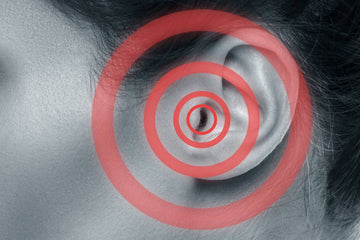
Hearing loss is a common condition that affects people of all ages. It can be a gradual process that creeps up on you, or it can occur suddenly. But did you know that there are actually different types of hearing loss?
Understanding the type of hearing loss you have is important, as it can help determine the best course of treatment and management. So, let's take a closer look at the different types of hearing loss, their causes, symptoms, and how they can impact your life.
What Is Hearing Loss?
Hearing loss is a condition where you have difficulty hearing sounds. It can range from mild to profound, affecting one or both ears.
In essence, hearing loss occurs when there's a problem with one or more parts of the ear:
- The outer ear: This is the part you see, responsible for collecting sound waves and channelling them into the ear canal.
- The middle ear: This part contains the eardrum and tiny bones (ossicles) that vibrate to transmit sound to the inner ear.
- The inner ear: This is where the magic happens. The inner ear contains the cochlea, a spiral-shaped structure filled with fluid and tiny hair cells. These hair cells convert sound vibrations into electrical signals that are sent to the brain, where they are interpreted as sound.
The Three Main Types of Hearing Loss
Hearing loss is generally categorised into three main types:
Sensorineural Hearing Loss
This is the most common type of hearing loss, occurring when there's damage to the inner ear, particularly the hair cells in the cochlea, or to the auditory nerve, which carries signals from the inner ear to the brain.
Conductive Hearing Loss
This type of hearing loss occurs when sound waves are blocked from reaching the inner ear. This blockage can occur in the outer ear canal or the middle ear.
Mixed Hearing Loss
As the name suggests, mixed hearing loss is a combination of sensorineural and conductive hearing loss. This means there's damage to both the inner ear and the outer or middle ear.
For more information on comparing conductive and sensorineural hearing loss, please do check out our linked blog on the subject.
Causes of Each Type of Hearing Loss
Each type of hearing loss has its own set of potential causes.
Common Causes of Sensorineural Hearing Loss
- Age-related hearing loss (presbycusis): This is a natural part of ageing, where the hair cells in the inner ear gradually deteriorate.
- Noise exposure: Loud noises, whether from concerts, machinery, or even headphones, can damage the hair cells in the inner ear.
- Certain medical conditions: Conditions like Ménière's disease, autoimmune diseases, and tumours can also cause sensorineural hearing loss.
- Genetics: Some people are predisposed to hearing loss due to their family history.
- Ototoxic medications: Certain medications, like some antibiotics and chemotherapy drugs, can be toxic to the inner ear.
Common Causes of Conductive Hearing Loss
- Earwax buildup: Excessive earwax can block the ear canal, preventing sound waves from reaching the eardrum.
- Ear infections: Infections in the middle ear can cause fluid buildup and inflammation, interfering with sound transmission.
- Otosclerosis: This condition involves abnormal bone growth in the middle ear, which can impede the movement of the ossicles.
- Foreign objects in the ear: Small objects, like beads or insects, can become lodged in the ear canal, blocking sound waves.
- Perforated eardrum: A hole or tear in the eardrum can disrupt sound transmission.
Common Causes of Mixed Hearing Loss
Mixed hearing loss can result from any combination of the causes mentioned above. For example, someone with age-related hearing loss (sensorineural) might also develop an ear infection (conductive), leading to mixed hearing loss.
How Each Type of Hearing Loss Affects Hearing Ability
The impact of hearing loss on your ability to hear depends on the type and severity of the condition.
Impact of Sensorineural Hearing Loss
Sensorineural hearing loss typically affects the ability to hear high-pitched sounds, making it difficult to understand speech, especially in noisy environments. It can also distort sounds, making them seem muffled or unclear.
Impact of Conductive Hearing Loss
Conductive hearing loss generally results in a reduction in overall sound volume, making everything seem quieter. It can also affect the clarity of speech.
Impact of Mixed Hearing Loss
Mixed hearing loss can present a combination of the effects mentioned above, depending on the specific combination of sensorineural and conductive components.
Diagnosing the Type of Hearing Loss
Determining the type of hearing loss requires a comprehensive assessment by a hearing healthcare professional.
Hearing Tests
Various hearing tests can help identify the type and severity of hearing loss. These tests typically involve listening to sounds at different frequencies and intensities and responding to them.
Medical Examinations
A physical examination of the ears can help identify any structural abnormalities or underlying medical conditions that might be contributing to the hearing loss.
Role of Audiologists and ENT Specialists
Audiologists are healthcare professionals specialising in the diagnosis and management of hearing loss. ENT specialists (otolaryngologists) are medical doctors who specialise in ear, nose, and throat disorders. Both play a crucial role in diagnosing and treating hearing loss.
Treatment Options for Different Types of Hearing Loss

The treatment for hearing loss depends on the underlying cause and the type of hearing loss.
Treatments for Sensorineural Hearing Loss
While sensorineural hearing loss is often permanent, there are ways to manage it and improve hearing. Hearing aids are a common solution, amplifying sounds to make them easier to hear. In some cases, cochlear implants might be an option for those with severe to profound hearing loss.
Treatments for Conductive Hearing Loss
Conductive hearing loss is often treatable, depending on the cause. Removing earwax buildup, treating ear infections, or surgically correcting structural abnormalities can often restore hearing.
Managing Mixed Hearing Loss
Managing mixed hearing loss typically involves addressing both the sensorineural and conductive components. This might involve a combination of hearing aids, surgery, or other treatments.
Can Hearing Loss Be Prevented?
Some types of hearing loss, like age-related hearing loss, are a natural part of ageing and can't be entirely prevented. However, there are steps you can take to protect your hearing and reduce your risk of noise-induced hearing loss:
- Limit exposure to loud noises: Wear earplugs or earmuffs in noisy environments.
- Turn down the volume: Keep the volume of your headphones and other audio devices at a safe level.
- Take breaks from noise: Give your ears a rest from loud noises throughout the day.
- Get regular hearing checkups: Early detection of hearing loss can help prevent further damage and ensure timely intervention.
Final Thoughts
Hearing loss can significantly impact your quality of life, but understanding the different types of hearing loss and their causes can empower you to take proactive steps to protect your hearing and seek appropriate treatment.
If you suspect you might have hearing loss, don't hesitate to schedule a hearing test with a qualified audiologist. Early intervention is key to managing hearing loss and maintaining your quality of life. And if you're ready to explore solutions to improve your hearing, you can order high quality hearing aids today from us at Hear Clear, your partner in affordable hearing care.



